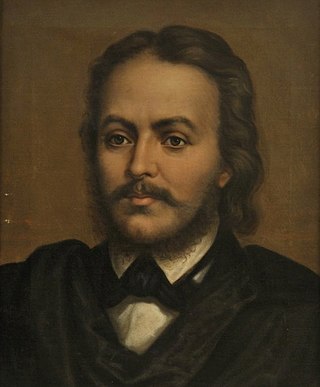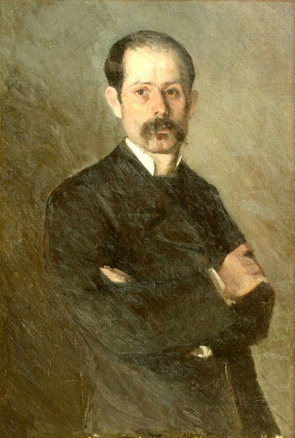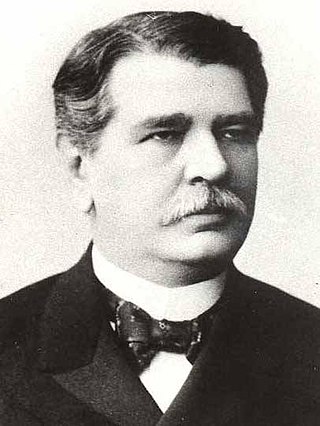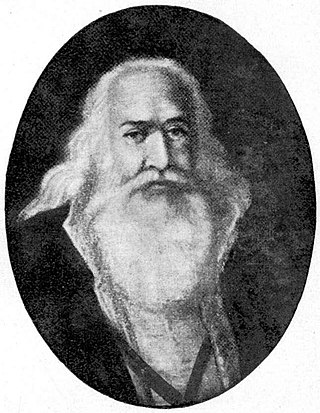
The University of Bucharest (UB) is a public research university in Bucharest, Romania. It was founded in its current form on 4 July 1864 by a decree of Prince Alexandru Ioan Cuza to convert the former Princely Academy into the current University of Bucharest, making it one of the oldest Romanian universities. It is one of the five members of the Universitaria Consortium.

Politehnica University of Bucharest is a technical university in Bucharest, Romania. 200 years of activity have been celebrated lately, as the university was founded in 1818. Politehnica University is classified by the Ministry of Education as an advanced research and education university.

Petre Sebeşanu Aurelian, 13 December 1833 – 24 January 1909, was a Romanian economist, politician and academic. A member of the National Liberal Party (PNL), he served as a Prime Minister of Romania between 2 December 1896 and 12 April 1897.

Gheorghe Lazăr, was a Transylvanian Romanian scholar, the founder of the first Romanian language school in Bucharest, 1817.

Ion Heliade Rădulescu or Ion Heliade was a Wallachian, later Romanian academic, Romantic and Classicist poet, essayist, memoirist, short story writer, newspaper editor and politician. A prolific translator of foreign literature into Romanian, he was also the author of books on linguistics and history. For much of his life, Heliade Rădulescu was a teacher at Saint Sava College in Bucharest, which he helped reopen. He was a founding member and first president of the Romanian Academy.

The Gheorghe Lazăr National College is a high school located in central Bucharest, Romania, at the southeast corner of the Cișmigiu Gardens, on the corner of Bulevardul Regina Elisabeta. One of the most prestigious secondary education institutions in Romania, it was named after the Transylvanian educator Gheorghe Lazăr, who taught at the Saint Sava College. Founded in 1860, it is the second oldest high school in Bucharest.

The Saint Sava National College, Bucharest, named after Sabbas the Sanctified, is the oldest and one of the most prestigious high schools in Romania. It was founded in 1694, under the name of the Royal Academy of Bucharest.

Ion Andreescu was a Romanian painter.

Barbu Ștefănescu Delavrancea; pen name of Barbu Ștefan; April 11, 1858 – April 29, 1918) was a Romanian writer and poet, considered one of the greatest figures in the National awakening of Romania.

Anghel Demetriescu was a Romanian historian, writer and literary critic, who became a member of the Romanian Academy in 1902.

Eufrosin Poteca was a Romanian philosopher, theologian, and translator, professor at the Saint Sava Academy of Bucharest. Later in life he campaigned against slavery. He was the grandfather of the Romanian philosopher Constantin Rădulescu-Motru.
Ioan Zalomit (1823–1885) was a Romanian philosopher, professor and rector of the University of Bucharest.
The Princely Academy of Bucharest was an institution of higher education, active from the end of the 17th century to the beginning of the 19th century.
The Princely Academy of Iași was an institution of higher learning, active in the 18th and 19th centuries.

Vasile Boerescu was a journalist, lawyer and Romanian politician who served as the Minister of Justice, Minister of Foreign Affairs, Minister of Religion and Public Instruction and held other various governmental offices during the existence of the United Principalities.

Grigore George Tocilescu was a Romanian historian, archaeologist, epigrapher and folkorist, member of Romanian Academy.
Nicolae P. Bănescu was a Romanian historian, elected a titular member of the Romanian Academy in 1936.
Nicolae Cartojan was a Romanian literary historian.

Silvia Șerbescu was a Romanian concert pianist. She was one of the first important concert pianists emerging from the Romanian piano school, and a distinguished piano pedagogue. Her interpretations of Rachmaninoff, Prokofiev and Debussy were memorable. From 1948 until 1965 she was a piano professor at the Bucharest Music Conservatory.
Constantin Noe was a Megleno-Romanian editor and professor. He was born in 1883 in the Megleno-Romanian village of Lagkadia, then in the Ottoman Empire and now in Greece. He was one of the best students of the Romanian Lyceum of Bitola, from which he graduated in 1903. On the same year, Noe became professor in several of the Romanian schools in the Balkans and one of the main figures of the Megleno-Romanian national movement. In 1907, he and several others of his colleagues were arrested and sentenced to four months in prison under the pretext of not using books approved by the General Directorate of Education of the Salonica vilayet of the Ottoman Empire in the schools they were teaching at.